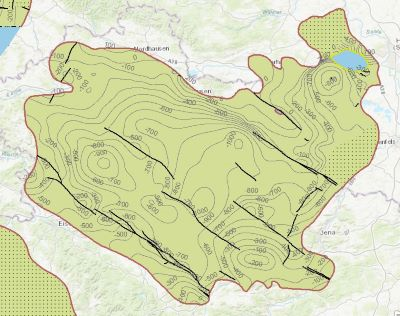Welche Salzformationen eignen sich zur Speicherung von Wasserstoff oder Druckluft? Im Forschungsprojekt InSpEE-DS entwickelten Wissenschaftler Anforderungen und Kriterien mit denen sich mögliche Standorte auch dann bewerten lassen, wenn sich deren Erkundung noch in einem frühen Stadium befindet und die Kenntnisse zum Aufbau der Salinare gering sind. Wissenschaftler der DEEP.KBB GmbH, Hannover erarbeiten gemeinsam mit ihren Projektpartnern der Bundesanstalt für Geowissenschaften und Rohstoffe und der Leibniz Universität Hannover, Institut für Geotechnik Hannover, Planungsgrundlagen zur Standortauswahl und zur Errichtung von Speicherkavernen in flach lagernden Salzen und Mehrfach- bzw. Doppelsalinaren. Solche Kavernen könnten erneuerbare Energie in Form von Wasserstoff oder Druckluft speichern. Während sich das Vorgängerprojekt InSpEE auf Salzformationen großer Mächtigkeit in Norddeutschland beschränkte, wurden jetzt unterschiedlich alte Salinar-Horizonte in ganz Deutschland untersucht. Zur Potenzialabschätzung wurden Tiefenlinienkarten des Top und der Basis sowie Mächtigkeitskarten der jeweils betrachteten stratigraphischen Einheit und Referenzprofile erarbeitet. Die Informationen zum Druckluft- und Wasserstoff-Speicherpotential in den einzelnen Bundesländern sind an die identifizierten Flächen mit nutzbarem Potential im Layer "Speicherpotenzial in den Bundesländern" gekoppelt. Mit Hilfe der getFeatureInfo-Anfrage erhält der User weitere Informationen zu den einzelnen Geometrien. Dies ermöglicht u. a. den Zugriff auf das Kriterienkatalog-Datenblatt im Layer "Potenzielle Speichergebiete flach lagernde Salze" jeder stratigraphischen Einheit und auf die Abbildungen von Bohrprofilen und Bohrungskorrelationen im Layer "Bohrungen und Bohrungskorrelationen". Eine räumliche Auswahl und Sachdatenabfragen sind für folgende Datensätze möglich: Bohrungen, Bohrungskorrelationen, Isobathen, Isopachen, Begrenzungselemente der Potenzialgebiete Top Zechstein, sowie das Speicherpotenzial in den Bundesländern und potenzielle Speichergebiete flach lagernder Zechsteinsalze. Der Darstellungsmaßstab hat eine untere Grenze von 1 : 300 000. Die Geodaten sind Produkte eines BMWi-geförderten Forschungsprojektes "InSpEE-DS" (Laufzeit 2015-2019). Das Akronym steht für "Informationssystem Salz: Planungsgrundlagen, Auswahlkriterien und Potenzialabschätzung für die Errichtung von Salzkavernen zur Speicherung von Erneuerbaren Energien (Wasserstoff und Druckluft) – Doppelsalinare und flach lagernde Salzschichten". Which salt formations are suitable for storing hydrogen or compressed air? In the InSpEE-DS research project, scientists developed requirements and criteria for the assessment of suitable sites even if their exploration is still at an early stage and there is little knowledge of the salinaries’ structures. Scientists at DEEP.KBB GmbH in Hanover, worked together with their project partners at the Federal Institute for Geosciences and Natural Resources and the Leibniz University Hanover, Institute for Geotechnics Hanover, to develop the planning basis for the site selection and for the construction of storage caverns in flat layered salt and multiple or double saliniferous formations. Such caverns could store renewable energy in the form of hydrogen or compressed air. While the previous project InSpEE was limited to salt formations of great thickness in Northern Germany, salt horizons of different ages have now been examined all over Germany. To estimate the potential, depth contour maps of the top and the base as well as thickness maps of the respective stratigraphic units and reference profiles were developed. The information on compressed air and hydrogen storage potential in the federal states is linked to the identified areas with usable potential in the Layer Storage potential in the federal states (Speicherpotenzial in den Bundesländern). Via the getFeatureInfo request, the user obtains additional information on the different geometries. This enables access to the criteria catalog data sheet in the layer Potential storage areas for flat layered salt (Potenzielle Speichergebiete flach lagernde Salze) of each stratigraphic unit and to the illustrations of borehole profiles and borehole correlations in the layers Boreholes (Bohrungen) and Borehole correlations (Bohrungskorrelationen). Spatial selection and data queries are possible for the following data sets: Boreholes (Bohrungen), Borehole correlations (Bohrungskorrelationen), Isobath (Isobathen), Isopach (Isopachen), Boundary elements of the potential areas Top Zechstein (Begrenzungselemente der Potenzialgebiete Top Zechstein), Storage potential in the federal states (Speicherpotenzial in den Bundesändern) and potential storage areas in the flat layered Zechstein salt (Potenzielle Speichergebiete flach lagernde Zechsteinsalze). The scale of display is limited to a minimum of 1:300.000. This geographic information is product of a BMWi-funded research project "InSpEE-DS" running from the year 2015 to 2019. The acronym stands for "Information system salt: planning basis, selection criteria and estimation of the potential for the construction of salt caverns for the storage of renewable energies (hydrogen and compressed air) - double saline and flat salt layers".





